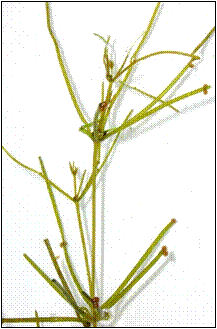|
"Your gateway to
understanding |
Starry Stonewort
click for full size
• Discovered in Oneida Lake in 2005
• Not a true plant—belongs to the algae family
• Can form dense mats on the lake’s bottom
Starry stonewort is native to Europe and western Asia and was likely introduced to North America in the ballast water of a transoceanic ship. It was found in the St. Lawrence River in 1978, but how it arrived in Oneida Lake is unclear. Discovered in Lower South Bay in 2005, a thick mat of this algae blanketed the bottom, preventing the growth of other plants. Interestingly, this algae is classified as endangered in Britain.
Starry stonewort looks like a plant but is actually a macroalgae, an early ancestor of plants. The stems are made up of several giant cells that are held together by “nodes” consisting of several smaller cells. Stoneworts anchor themselves to the bottom with colorless hair-like filaments called rhizoids. Rhizoids act as roots, absorbing nutrients and providing stability. Stoneworts also have the ability to absorb nutrients through all surfaces, not just the rhizoids. They live in fresh or brackish water and can tolerate low nutrient and light levels. Starry stonewort can be found at depths of 3-20 feet in lakes or slow moving rivers.
Oneida Lake has a native stonewort with the scientific name Chara vulgaris. This algae occurs in lakes like Oneida that have hard water and often has incrustations of lime. Chara is considered a primitive algae and recently has increased in abundance in Oneida Lake since the 1990s.
To learn more about Starry Stonewort ...

